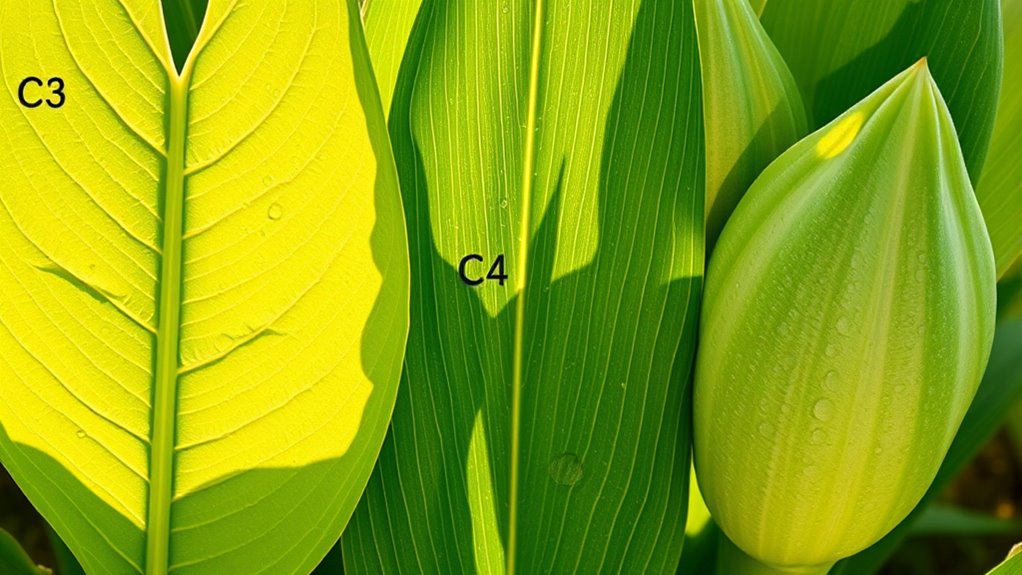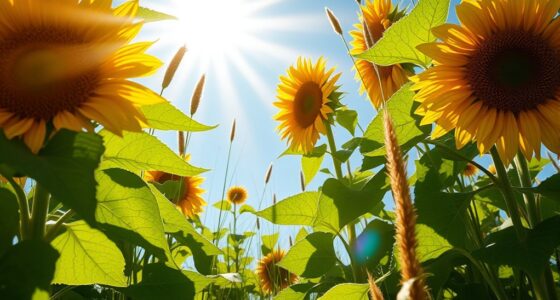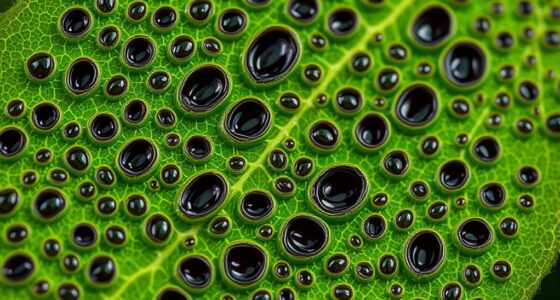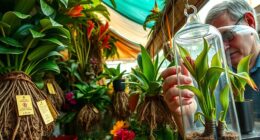Understanding the differences between C3, C4, and CAM leaf strategies helps you see how plants optimize photosynthesis for various environments. C3 plants work best in cool, moist conditions but are less water-efficient under heat. C4 plants excel in hot, dry settings by minimizing photorespiration, boosting yields. CAM plants thrive in deserts, conserving water by opening stomata at night. Keep exploring to discover how these strategies are reshaping agricultural productivity and ecosystems.
Key Takeaways
- C3 plants perform best in cool, moist environments but are less efficient under high temperatures due to photorespiration.
- C4 plants optimize productivity in hot, dry climates by minimizing photorespiration and conserving water.
- CAM plants adapt to extreme aridity by opening stomata at night for CO2 intake, greatly enhancing water-use efficiency.
- The leaf strategies of each type influence crop yields, with C4 and CAM plants excelling in challenging environmental conditions.
- Understanding these mechanisms helps optimize agricultural practices based on environmental constraints and yield potential.
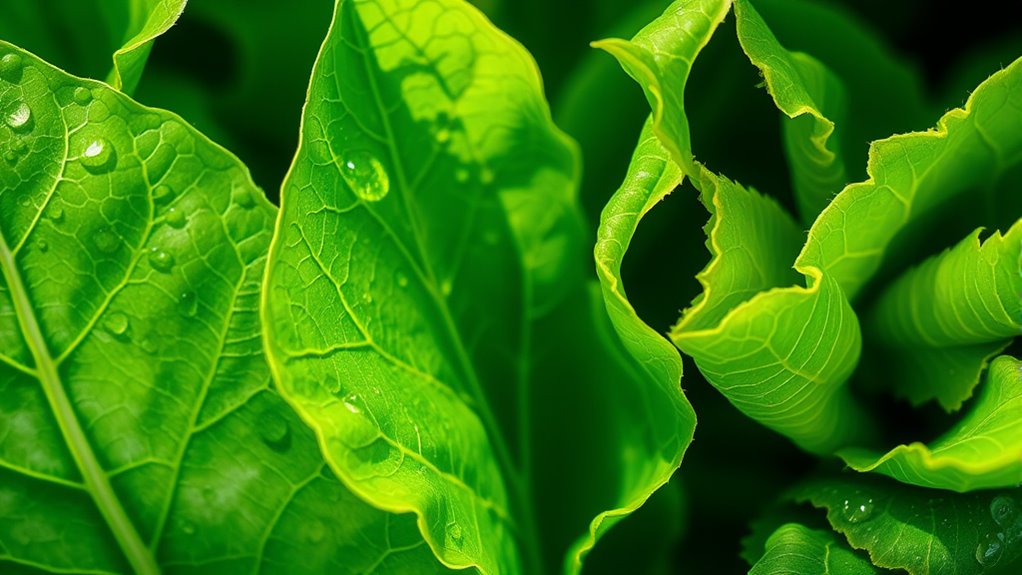
Have you ever wondered how different plants adapt their photosynthesis processes to survive in various environments? It’s fascinating to see how nature has evolved multiple strategies to optimize energy capture and water conservation. When you look at a green leaf, you’re witnessing just a small part of a complex system that varies markedly among plant types. Understanding these differences, especially between C3, C4, and CAM plants, can give you insight into how plants thrive in diverse conditions and also influence agricultural productivity.
Exploring how C3, C4, and CAM plants adapt their photosynthesis for survival and productivity.
C3 plants are the most common, making up about 85% of plant species, including wheat, rice, and soybeans. They perform photosynthesis through a process where the enzyme Rubisco fixes CO2 directly into a three-carbon compound. This method works well in moderate, cool, and moist environments. However, it’s less efficient under high temperatures or intense sunlight because Rubisco can mistakenly bind oxygen instead of CO2, leading to photorespiration — a wasteful process that reduces overall efficiency. As a result, C3 plants often struggle in hot, dry conditions and tend to lose water quickly through transpiration.
C4 plants, like maize, sugarcane, and millet, have developed a different approach to photosynthesis. They initially fix CO2 into a four-carbon compound in mesophyll cells, which is then transported to bundle-sheath cells where the Calvin cycle occurs. This spatial separation minimizes photorespiration, especially under high temperatures and intense sunlight. Because of this adaptation, C4 plants can maintain high photosynthetic rates with less water loss compared to C3 plants. That makes them particularly suited to hot, arid environments where water conservation is essential. You’ll notice that C4 plants are often more productive in such conditions, making them indispensable crops in many regions.
Then there are CAM plants, like cacti, succulents, and pineapples, which have a different strategy altogether. They open their stomata at night to take in CO2, storing it as malic acid. During the day, when sunlight is available, they close their stomata to conserve water and use the stored CO2 for photosynthesis. This temporal separation allows CAM plants to thrive in extremely dry environments where water is scarce. It’s a remarkable adaptation that lets them survive where other plants would wilt or die. You might see these plants in deserts or arid landscapes, thriving despite harsh conditions. Interestingly, CAM plants also exhibit a high water-use efficiency, making them vital for survival in desert ecosystems.
Frequently Asked Questions
How Do Environmental Conditions Influence Each Leaf Strategy’s Efficiency?
Environmental conditions greatly influence each leaf strategy’s efficiency. You’ll find C3 plants perform best in cool, moist environments because they efficiently fix carbon when conditions are stable. C4 plants excel in hot, sunny, and dry conditions, minimizing water loss and maximizing photosynthesis. CAM plants adapt to arid environments by opening their stomata at night, conserving water. Understanding these conditions helps you predict which strategy will be most effective in different climates.
Can Plants Switch Between C3, C4, and CAM Pathways?
Yes, you can think of plants as adaptable dancers switching steps to match the music. They often shift between C3, C4, and CAM pathways depending on environmental cues like light, water, and temperature. This flexibility helps them conserve resources or maximize photosynthesis. While some plants chiefly use one pathway, others are capable of switching or performing multiple, showcasing their remarkable ability to adjust and thrive in changing conditions.
What Are the Evolutionary Advantages of Each Photosynthetic Pathway?
You benefit from each pathway’s advantages based on your environment. C3 plants excel in cooler, wetter climates with efficient photosynthesis. C4 plants thrive in hot, sunny areas by minimizing water loss and increasing carbon fixation efficiency. CAM plants adapt to arid conditions, opening stomata at night to conserve water. These strategies help you survive and reproduce in diverse environments, enhancing your chances of success across different ecosystems.
How Do These Strategies Affect Water Conservation in Plants?
You conserve water by adopting different strategies: C4 plants minimize water loss through efficient carbon fixation, C3 plants lose more water due to open stomata, and CAM plants open stomata at night, reducing evaporation. These adaptations help them thrive in their environments, with each pathway optimizing water use to balance photosynthesis and water conservation. Your choice of strategy directly influences how effectively your plant uses water under varying conditions.
Are There Crops That Utilize More Than One Photosynthetic Pathway?
Yes, some crops can switch between different photosynthetic pathways depending on environmental conditions. For example, certain succulents and halophytes use both C3 and CAM strategies, optimizing water conservation and energy efficiency. While most crops stick to one pathway, research is ongoing to develop flexible plants that adapt to stress, potentially improving yields and sustainability in changing climates.
Conclusion
Understanding C3, C4, and CAM plants is like choosing the right tool for a job—you’ll want the best fit for your environment. Each strategy is a unique leaf on the tree of life, adapting to thrive under different conditions. By mastering these plant tricks, you can optimize yields and boost sustainability. Think of it as revealing nature’s secret recipe—each method adding its own flavor to the garden of agriculture.

